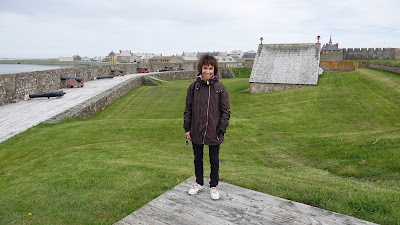We had breakfast at the hotel and then left to drive to drive two hours to Louisbourg National Park. This was the first settlement in Canada. First, we visited the site of the first lighthouse built in Canada. The original one was replaced by another years later. It provided protection for the fishing fleets that came from France to harvest the cod. Then we went to the reconstructed fortress of Louisbourg across the harbour from the lighthouse. This was an ice-free harbour and important to France as it allowed year round fishing and trading. Thirty million pounds of cod were caught here annually and shipped back to France. This was at the time the sole (pardon the pun) reason for the mother country’s interest in North America.
The following is from the Parks Canada website:
“Fortress of Louisbourg was designated a national historic site of Canada because: between 1713 and 1768 it was a place of profound significance in the great France-British struggle for empire. The Fortress of Louisbourg was established by France as a critical fishing, trans-shipment and supply port for its maritime empire. As administrative capital of the French colonies of Ile Royale (the French name for Cape Breton) including Ile-St-Jean, it was home to the local government, an established military garrison and civilian population. It was also an important mercantile centre for French ships trading around the world and for development of a North American trading empire based on the fishery. As such, Louisbourg was a fortified town. It was a strategic base for protection of the lucrative French fishery and off-shore trade as well as guarding approaches to the Gulf of St. Lawrence, the main shipping route to Quebec and the North American interior. As a critical French asset, Louisbourg was a point of contention between French and British governments. It was besieged and captured by the British in 1745 and again in 1758. The British systematically demolished its fortifications in 1760-1768 and abandoned the town by the mid-1780s. Parks Canada has reconstructed approximately a quarter of the walled townsite (1961-81).”
We took a guided tour, where we
learned the difference between a fort and a fortress: a fort is a military structure
and a fortress is a walled town with military protection. Then wandered
around by ourselves visiting many of the buildings and talking to the people
who were dressed in period costumes and role playing various jobs. It was quite
cool so we stopped in a little snack bar and had a heritage hot chocolate. Then
we retraced our route and returned to Baddeck. We shopped for some food stuffs
at the local Co-Op grocery and booked another hotel for the night. This one is
called the Inverary Resort and is very nice. It is literally across the road
from the other two. We had heard about the Acadian ‘Ceilidh’ from several
people. It is pronounced ‘kay-lee’ and means party. We learned there was one held
every Wednesday night at the Gaelic College in St Ann. We drove about 15
minutes to get there. It was held in the hall of this internationally famous
college which claims to exist to preserve the Scottish culture, language, and
traditions of Gaelic. We watched six incredibly talented musicians in various
combinations perform numerous love songs and reels on fiddle, guitar, piano and
Bodhran, a handheld drum. We talked to the female fiddler afterwards who works
at the college. We assumed was a teacher and found that she worked at the college
in the finance department. She said just about everybody at the college plays
something. She told us that she lived in the area as a child and her parents left
her at the college for three weeks at a time. She said it was magical and in
those days they all wore kilts. Then we drove back to Baddeck again and checked
out the open mic entertainment in the hotel lobby, which was dreadful, but the
beer was good. Then we retired after another excellent day.











Bet this was an illuminating experience Joe ;-) great to see you travelling and blogging again. Keep up the interesting stories and the photographs. The wildlife shots are really getting better!
ReplyDelete